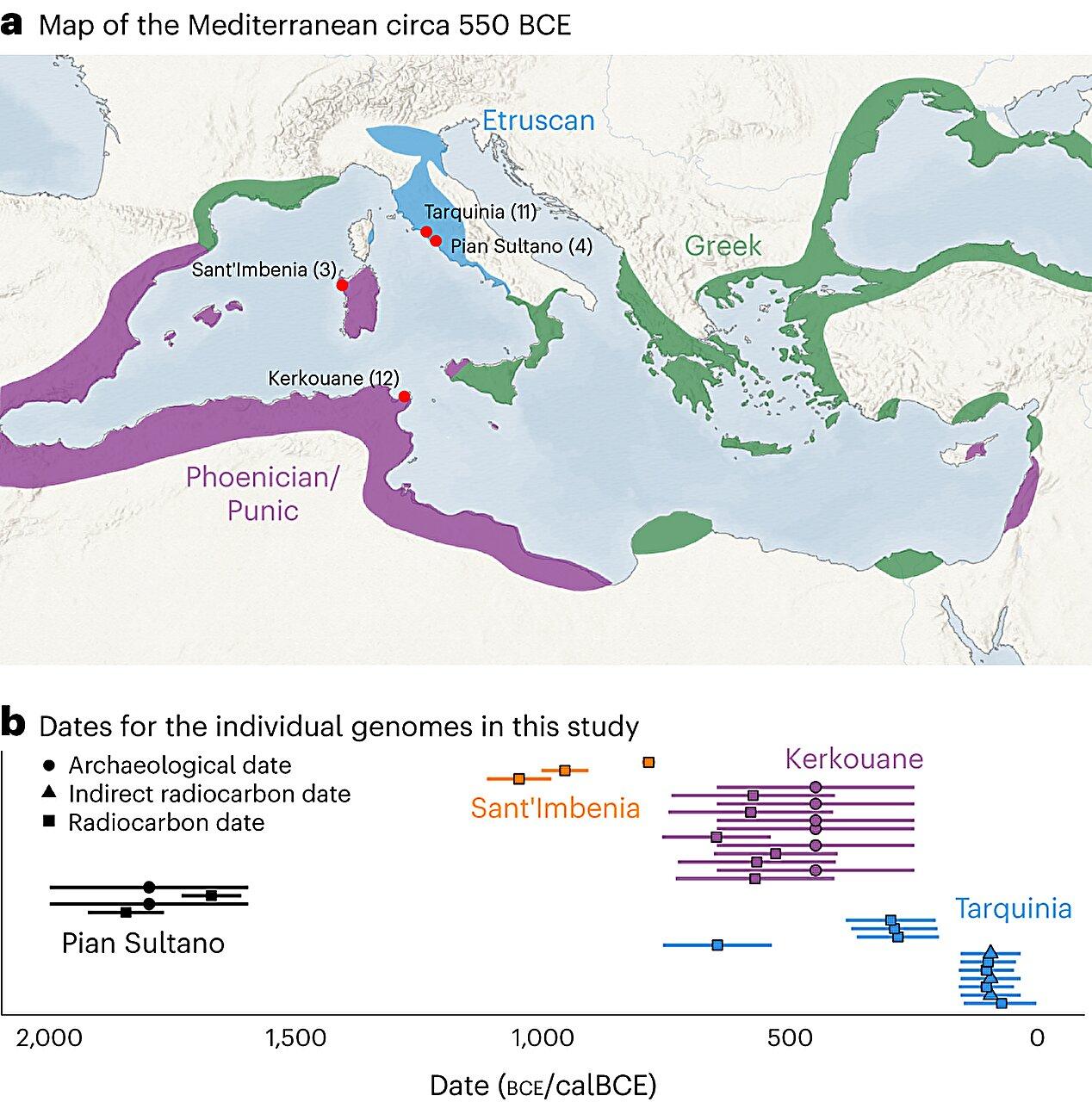Bob Yirka , Phys.org
Source - https://phys.org/news/2023-08-sequencing-genes-iron-bronze-age.html
 Data overview and relevant geography and chronology. a, Locations of the 4 archaeological sites examined here, as well as a map of the areas settled by Phoenician, Greek and Etruscan speakers by 550 BCE. b, Timeline showing the dates for the newly reported individual genomes, with the methods of dating indicated. Indirect radiocarbon dating refers to using the radiocarbon date of a different individual in the same tomb. A single date estimate for each individual in the study was determined by the average of lower and upper estimates of the 95% confidence interval when using accelerator mass spectrometry radiocarbon dates and the average of the lower and bound inference dates when using archaeological and historical context for dating. The full 95% confidence intervals are reported in Supplementary Dataset 3. The map was generated using the World_Basemap_v2 from the ArcGIS online platform. Credit: Nature Ecology & Evolution (2023). DOI: 10.1038/s41559-023-02143-4
Data overview and relevant geography and chronology. a, Locations of the 4 archaeological sites examined here, as well as a map of the areas settled by Phoenician, Greek and Etruscan speakers by 550 BCE. b, Timeline showing the dates for the newly reported individual genomes, with the methods of dating indicated. Indirect radiocarbon dating refers to using the radiocarbon date of a different individual in the same tomb. A single date estimate for each individual in the study was determined by the average of lower and upper estimates of the 95% confidence interval when using accelerator mass spectrometry radiocarbon dates and the average of the lower and bound inference dates when using archaeological and historical context for dating. The full 95% confidence intervals are reported in Supplementary Dataset 3. The map was generated using the World_Basemap_v2 from the ArcGIS online platform. Credit: Nature Ecology & Evolution (2023). DOI: 10.1038/s41559-023-02143-4
An international team of anthropologists, archaeologists and geneticists has learned more about the migration patterns of people living around the Mediterranean Sea during the Iron and Bronze ages. In their study, reported in the journal Nature Ecology & Evolution, the group conducted genetic sequencing on the remains of 30 people who lived during the Iron or Bronze Age in Italy, Tunisia and Sardinia.
As the researchers note, most knowledge of people living around the Mediterranean Sea during the Iron and Bronze Ages derives from study of artifacts they left behind. But such evidence, they point out, does not reveal much about the backgrounds of those people or where their ancestors came from. In this new effort, the research team sought to learn more about the backgrounds of such people by following migration patterns using genetic sequencing.
The researchers conducted shotgun sequencing (sequencing conducted in random fashion) on samples collected from unearthed bones of ancient people living in Italy, Tunisia and Sardinia to get a sense of migration patterns for people living in the northern, central and southern parts of the eastern part of the Mediterranean during the Iron and Bronze Ages—a time, the researchers note, when people were traveling greater distances due to advances in boat and shipbuilding. The team then compared their findings to the results of other sequencing efforts conducted on both modern and ancient peoples living in the region.
They found evidence of widespread migration around the Mediterranean, suggesting strong ties between distant people. They also found heterogeneity in Iron Age populations and shifts in ancestry in North Africa and Sardinia during the Bronze Age, suggesting an uptick in migration. More specifically, the research revealed an increase in migration from what is now Morocco and Iran by neolithic farmers to both Sardinia and Tunisia, and somewhat less migration to what is now Italy.
The research team suggests that there was an increase in migration, as expected during both the Iron and Bronze Ages, as people sailed the Mediterranean Sea for a myriad of reasons—and in so doing, shaped the ancestry of those who lived in the region.
Hannah M. Moots et al, A genetic history of continuity and mobility in the Iron Age central Mediterranean, Nature Ecology & Evolution (2023). DOI: 10.1038/s41559-023-02143-4.